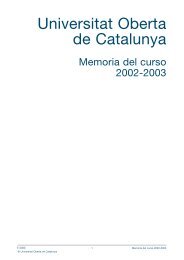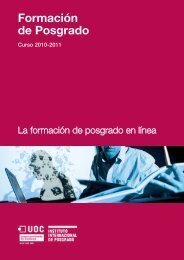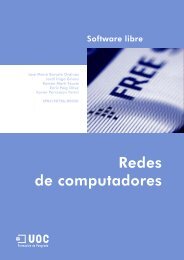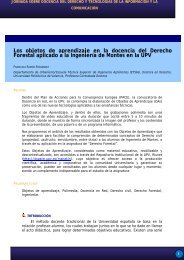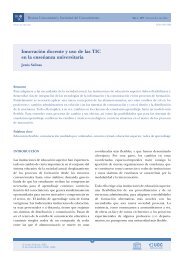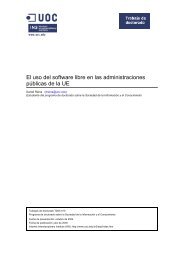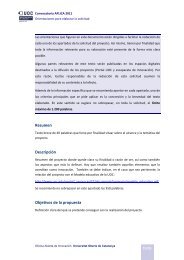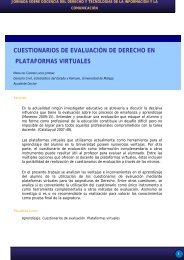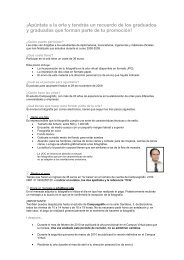e-governance and citizen information - Universitat Oberta de ...
e-governance and citizen information - Universitat Oberta de ...
e-governance and citizen information - Universitat Oberta de ...
Create successful ePaper yourself
Turn your PDF publications into a flip-book with our unique Google optimized e-Paper software.
E-<strong>governance</strong> <strong>and</strong> Citizen Information 30 Theoretical Framework. The Network AdministrationHowever, the concepts of “centrality of the <strong>citizen</strong>” or “centrality of <strong>de</strong>m<strong>and</strong>” are often usedin a rhetorical <strong>and</strong> quite ambiguous approach. In each case, we should un<strong>de</strong>rst<strong>and</strong> how theyare specifically operationalised <strong>and</strong> what type of actions, programs or initiatives or proceduresare established to i<strong>de</strong>ntify <strong>and</strong>/or characterise <strong>citizen</strong>s' needs or <strong>de</strong>m<strong>and</strong>s (with surveys,focus groups, etc.). Since these “user” configuration processes can be very different,general formulations are not very useful for analysis.In addition, within e-government studies, two types of analysis stood out: comparative studiesof government portals <strong>and</strong> studies on good practices. These analyses were <strong>de</strong>velopedby university <strong>and</strong> research centres, as well as consultancies from the private sector <strong>and</strong> internationalorganisms (Accenture, 2003 <strong>and</strong> 2004; Gartner Group, 2000; Demchak et al.,2000; SIBIS, 2003; Wong <strong>and</strong> Welch, 2004; Dunleavy et al., 2003).For different reasons, the comparative studies of government portals acquired a central rolein what can be consi<strong>de</strong>red as the first stage in the <strong>de</strong>velopment of e-government. This waspartly due to the fact that portals quickly became a new space for the management <strong>and</strong> communicationswith <strong>citizen</strong>s. And from the perspectives of analysts, the strength of these studiesis that they have the advantage of allowing comparison of a large number of cases witha relatively low cost in terms of resources <strong>and</strong> time. However, their weakness lies in the factthat an analysis does not allow us to un<strong>de</strong>rst<strong>and</strong> where the Administration is changing, sincethese analyses are generally focused on the external transformations <strong>and</strong> those that aremost visible from the portals.We can make a similar criticism of the “good practices” studies <strong>de</strong>veloped mainly by consultancies,(Accenture, 2003, 2004; Gartner Group, 2000). The focus was mainly on the <strong>de</strong>signof initiatives, without an analysis of the uses <strong>and</strong> global results of the technological incorporationprocesses. Two criticisms show the basic problems of these approaches: A <strong>de</strong>terministicvision of technology, conceived as an efficient recipe per se for changing the state ofaffairs; <strong>and</strong> a “<strong>de</strong>politicised”, or at least <strong>de</strong>contextualised conception of the Public Administration,where innovation would arrive without the mediation of contexts <strong>and</strong> actors. One ofthe consequences is the perception of both the problems <strong>and</strong> their solutions, which can beextrapolated with no major difficulties to different institutional contexts (Aibar <strong>and</strong> Urgell,2003; Fountain, 2001).Nevertheless, in recent years the studies that incorporate organisational changes havestarted to grow in importance. Therefore, for example Layne <strong>and</strong> Lee (2001) establishesa mo<strong>de</strong>l with four stages: a) cataloguing, which involves the offer of <strong>information</strong>; b)transaction, which allows complete electronic transactions <strong>and</strong> therefore starts a twoway<strong>information</strong> flow; c) a vertical integration stage, which involves the integration of dif-http://www.uoc.edu/in3/pic




